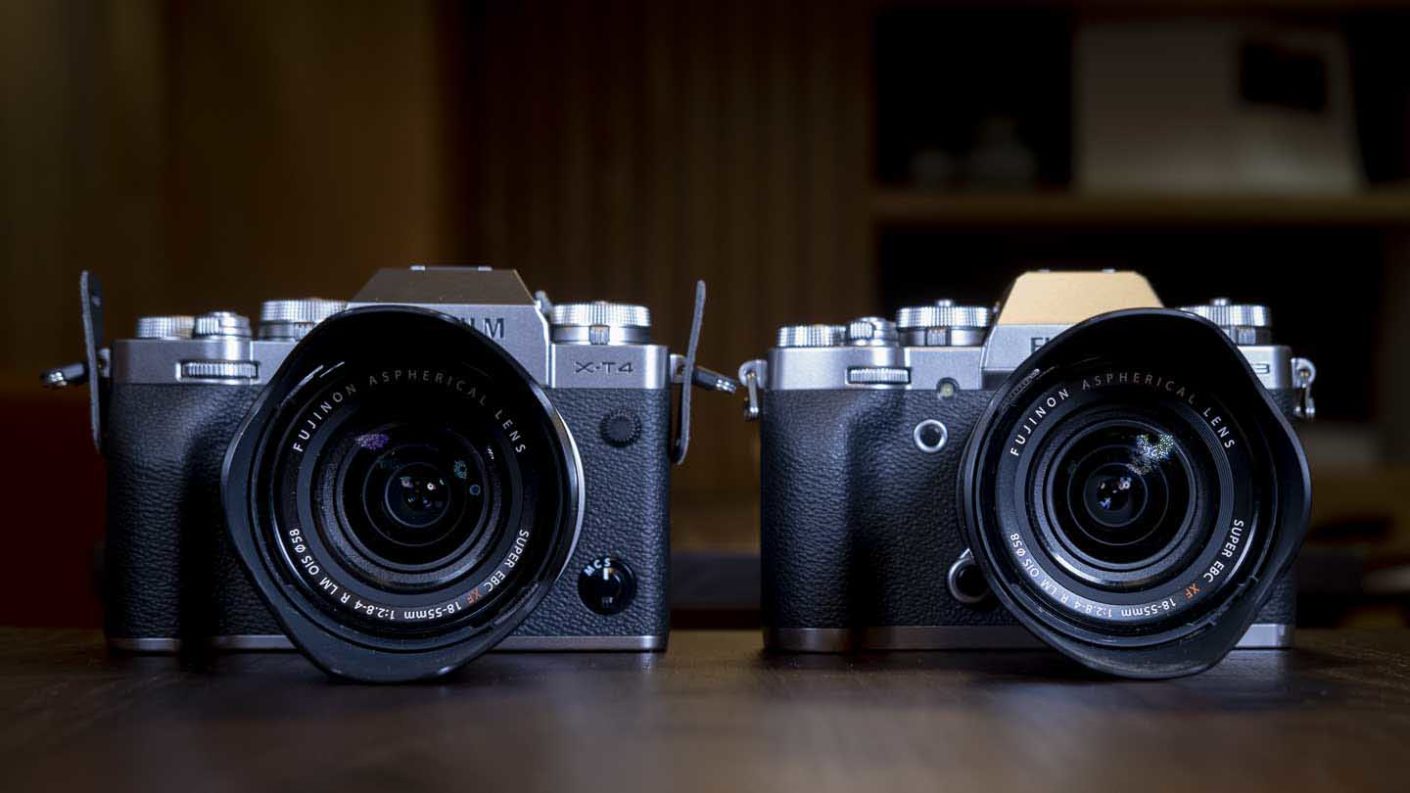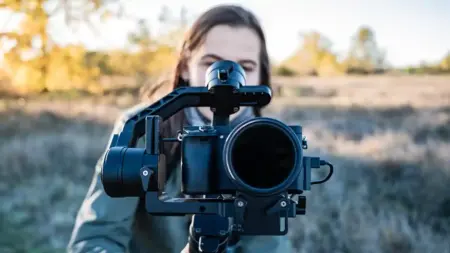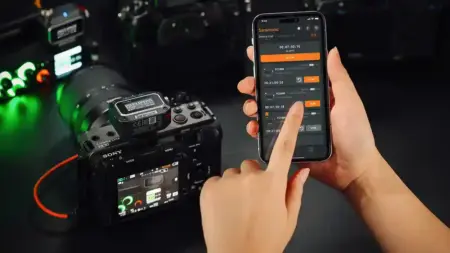In many ways the Fujifilm X-T4 is very much the same as the X-T3. And yet, in some key areas Fujifilm made some major upgrades, giving the X-T4 a significant advantage over its predecessor. Is it enough for you to sell your X-T3 and upgrade? In this Fujifilm X-T4 vs X-T3 comparison we compare the specs of both cameras to see where the key differences lie.
For many Fujifilm X-T3 owners, the most significant difference – and the reason most might want to upgrade – is the addition of in-body image stabilisation (IBIS). For more information, check out our in-depth guide to which cameras have IBIS.
The X-T4 isn’t the first Fujifilm camera to offer IBIS. The Fujifilm X-H1 debuted this technology in the range, and many probably expected the X-T3 to inherit this functionality. The X-H1 was a large camera, though, (for a mirrorless camera). In the X-T4, Fujifilm has slimmed down the IBIS unit by nearly a third, which has enabled the company to design the unit significantly smaller and lighter and allow it to fit inside the body of an X-T series camera.
Overall, the Fujifilm X-T4’s 5-axis in-body image stabilisation unit provides a shutter speed compensation value of 6.5 EV.
Other key additions to the X-T4 include a new mechanical shutter unit that’s quieter than the X-T3 and allows faster continuous shooting at 15fps.
Also new is a battery that offers more capacity and thus longer shooting life. Fujifilm’s NP-W235 has around 1.5X the capacity of the NP-W126S battery used in the X-T3. This extends the life on a single charge to around 500 images in Normal mode and 600 frames in Economy mode.
Now let’s take a look at some of the core specifications and how they stack up in a Fujifilm X-T4 vs X-T3 comparison.
Sensor
- Both cameras: 26.1MP X-Trans CMOS 4 APS-C sensor
In the X-T4, Fujifilm has stuck with the same 26.1-megapixel X-Trans CMOS 4 sensor that debuted in the X-T3. The sensor which sits in both cameras is backside-illuminated, meaning that its pixels sit closer to the surface of the chip, which boosts their ability to capture light.
Fujifilm’s CMOS sensor design requires no optical low-pass filter to ensure natural colours and prevent distortion. And over the years, Fujifilm’s APS-C format sensors have often outperformed others in their ability to capture detail.
Processor
- Both cameras: X-Processor 4
Like the X-T3, Fujifilm stuck with its fourth-generation X-Processor 4 engine in the Fujifilm X-T4. This engine helps deliver AF speeds of 0.06sec and shutter release lag of just 0.045sec, as well as an EVF refresh rate of 100fps.
Autofocus system
- Both cameras: Intelligent hybrid with up to 425 selectable AF points
Much like the sensor and processing engine, Fujifilm has given the X-T4 the same AF system as the X-T3. Both cameras feature the same Intelligent Hybrid AF system that utilises both phase and contrast detection.
Users will find up to 425 selectable AF points in Single Point AF mode. These are arranged in a 25 x 17 grid. Or you can set the grid to 13 x 9 with 117 points. In this mode you can also adjust the size of the points.
Both cameras also offer a Zone AF mode, which allows you to select AF points in 3 x 3, 5 x 5 or 7 x 7 groups.
One difference, however, is in the AF algorithm. Fujifilm says it tweaked the algorithm for the X-T4, which gave it a bit of a speed boost. The X-T4’s continuous AF mode and Face & Eye AF and AF Tracking functionality all are improved from the X-T3.
Video
- Both cameras: 4K at up to 60p (X-T4: MOV and MP4; X-T3: MOV)
Fujifilm was a bit of a trailblazer in giving the X-T3 the capability to record 4K video at 60p. And likewise, the X-T4 can shoot C4K (4096 x 2160) MOV video at up to 60p. The difference this time, though, is the X-T4 can also record in MP4 format.
What’s more, slow motion fans will appreciate the opportunity to record Full HD video at up to 240p in the X-T4. This is twice the frame rate possible at this resolution in the X-T3. Fujifilm has also added Digital IS and IS Mode Boost options to the X-T4 to help users capture more stable footage.
Other video improvements in the X-T4 include F-Log View Assist, back-up recording and the ability to fix the movie crop so that the framing stays the same even if you switch between different resolutions.
In addition, the 3.5mm mic jack can be set to Mic or Line (depending upon what you want to connect) and there’s control over the level.
Viewfinder
- Both cameras: 3.69-million-dot high resolution EVF (100% coverage)
Fujifilm stuck with the same 0.5-inch 3.69-million-dot electronic viewfinder that debuted in the X-T3. This EVF has the option to not apply your camera settings that give you a preview of the exposure and colour so that it replicates the look of a DSLR.
Screen
- Fujifilm X-T4: Vari-angle 3-inch 1.6-million-dot touch screen LCD
- Fujifilm X-T3: Dual-tilt 3-inch 1.04-mllion-dot touch screen
Fujifilm upgraded its rear LCD screen with the X-T4. While the X-T3 boasts a bright 3-inch, 1.04-million-dot screen that’s touch-sensitive, the X-T4 takes it a step further with a 1.6-million-dot screen.
What’s more, while the X-T3 offered a big improvement over the X-T2’s screen with a dual-tilt mechanism, the X-T4 incorporates a vari-angle screen. The X-T3’s dual-tilt mechanism enables you to adjust the screen to a more convenient angle, whether you’re shooting in upright or horizontal orientation.
The X-T4’s vari-angle screen, however, is ideal for both video and stills photographers. The new hinge means you can flip the screen around for viewing in front of the camera – making it one of the best cameras for vlogging. It also means you can swing the screen out to the side of the camera and get a clear view when shooting with the camera below eye-level.

Should I sell my Fujifilm X-T3?
Although the image quality is basically the same, the Fujifilm X-T4 offers some pretty significant improvements over the X-T3. With 5-axis in-body image stabilisation that offers shutter speed compensation of 6.5 EV, you have so much flexiblity to shoot handheld in a wider range of conditions. What’s more, the X-T4’s IBIS works with the IS in Fujifilm’s stabilised lenses to provide even great stability.
Couple this with a quieter mechanical shutter, a longer-lasting battery, faster continuous shooting and that all-important ability to record 4K video at 60p, and the Fujifilm X-T4 looks like the best X-series camera to date.
Should you sell your Fujifilm X-T3? Yes, you should. The improvements in the X-T4 are significant, and it is by many standards a complete camera which is capable of many things.
Sponsored: Thinking of selling your Fujifilm X-T3 to upgrade? Get a free instant quote from MPB and find out what your kit is worth. Selling your gear to MPB is easy and secure. Plus get free doorstep pickup and super-fast payment. We’re loved and trusted by more than 250,000 visual storytellers around the world and we’re rated excellent with five stars on Trustpilot. Buy. Sell. Trade. Create.





Leave a Reply